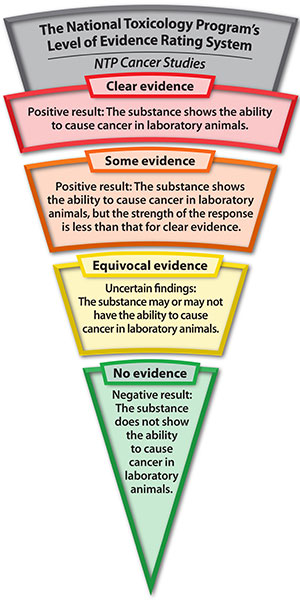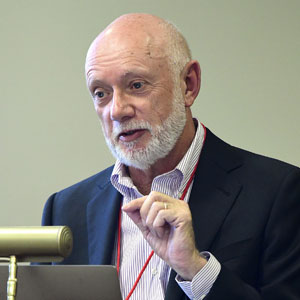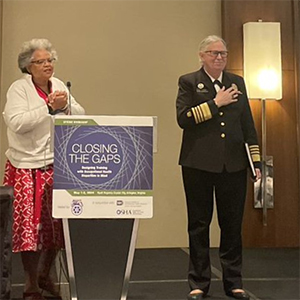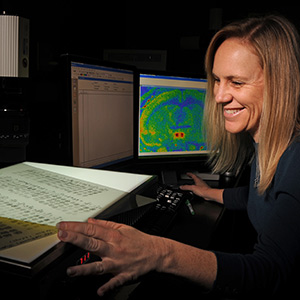Natural disasters, exposures with unknown health effects, and respiratory diseases caused by inhalation of harmful agents are just a few of the topics discussed at the April 23 meeting of the National Toxicology Program (NTP) Board of Scientific Counselors, held online.
 “Inhalation exposures are occurring every day, often as complex mixtures, and this contributes to disease burden in our society,” said Ryan. (Photo courtesy of Steve McCaw / NIEHS)
“Inhalation exposures are occurring every day, often as complex mixtures, and this contributes to disease burden in our society,” said Ryan. (Photo courtesy of Steve McCaw / NIEHS)Scientists from the NIEHS Division of NTP (DNTP) discussed two initiatives to both improve public health and advance toxicological science — the Occupational and Inhalation Exposures (OIE) Program and the Emerging Contaminants and Issues of Concern (ECIC) Program.
Harmful workplace inhalation
“Indoor and outdoor air pollution can contribute to respiratory problems such as chronic obstructive pulmonary disease and asthma,” said DNTP toxicologist Kristen Ryan, Ph.D., who helps to manage the OIE program (see first sidebar). “That pollution also can play a role in adverse health outcomes influenced by genetics, socioeconomics, and occupation.”
She pointed to information from the National Institute for Occupational Safety and Health that about 70% of all work-related disease deaths were from respiratory disease and malignancies.
“While most hazardous inhalation exposures occur with chemical production or manufacturing, jobs involving cleaning, waste handling, construction, transportation, or medical industries also lead to exposures of concern,” said Ryan.
 “Inhalation exposures to toxic compounds tend to be weighted to occupational settings, and thus, efforts to mitigate them are the focus of many organizations, including DNTP,” said Ryan. (Image courtesy of NIEHS)
“Inhalation exposures to toxic compounds tend to be weighted to occupational settings, and thus, efforts to mitigate them are the focus of many organizations, including DNTP,” said Ryan. (Image courtesy of NIEHS)Analyzing airborne substances
OIE goals include the following, according to Ryan.
- Assess potential health risks of airborne substances of concern using a combination of traditional and alternative experimental methods.
- Predict adverse effects to airways and lungs and generate data about the biological mechanisms involved. Use cutting-edge, human-relevant micro-physiological systems, such as air-liquid interface cell cultures and lung-on-chip systems.
- Enhance human relevance of in vivo and in vitro experimental models through human exposure studies, literature-based assessments, animal studies, and specialized techniques for studying tissues, among other approaches.
“DNTP already has established robust and unique capabilities to evaluate inhalation toxicity or other complex exposures,” Ryan told board members. “We aim to use our resources and infrastructure to expand the tools in our toolbox and better protect public health.”
Natural disasters, chemical spills, plastics
 “Engaging communities and translating data, particularly when those communities would be most vulnerable to a particular ECIC, is critical,” said Mutlu. (Photo courtesy of Steve McCaw / NIEHS)
“Engaging communities and translating data, particularly when those communities would be most vulnerable to a particular ECIC, is critical,” said Mutlu. (Photo courtesy of Steve McCaw / NIEHS)Wildfires, chemical spills, and exposure to plastics are examples of emergency situations and novel human health concerns that arise unexpectedly, yet regularly, according to DNTP chemist Esra Mutlu, Ph.D., who helps manage the ECIC program.
“In those circumstances, decision-makers need timely access to high-quality actionable information to protect public health,” said Mutlu. “However, effective and rapid mobilization of scientific resources in response to such situations can be challenging.”
DNTP scientists will address the problem by strategically identifying ECICs with limited toxicological data, especially those affecting marginalized and underserved populations. To expand scientific capabilities, fill research gaps, and rapidly share findings, DNTP will enhance communication with stakeholders and the public.
All about collaboration
DNTP scientists are already evaluating the following ECICs.
- Boron(https://ntp.niehs.nih.gov/whatwestudy/testpgm/status/ts-10035-d.html), a drinking water contaminant.
- Chronic kidney disease of unknown origin.
- Sulfolane(https://ntp.niehs.nih.gov/whatwestudy/topics/sulfolane/), a drinking water contaminant.
“It is extremely important to break silos and collaborate to address these issues,” said Mutlu. “We are in a unique position to respond to these emerging issues and provide actionable, translatable, and timely products,” she added. As an example, Mutlu pointed to DNTP research on synthetic turf made with crumb rubber(https://ntp.niehs.nih.gov/whatwestudy/topics/syntheticturf/).
“Our efforts will contextualize toxicological data so that people better understand how environmental exposures may affect human health,” she explained.
 “High-quality reliable data are necessary to determine which substances have hazard potential, so that measures can be enacted to limit exposure and risks to the public,” said Mutlu. (Photo courtesy of IVASHstudio / Shutterstock.com)
“High-quality reliable data are necessary to determine which substances have hazard potential, so that measures can be enacted to limit exposure and risks to the public,” said Mutlu. (Photo courtesy of IVASHstudio / Shutterstock.com)Bucher recognized
DNTP Senior Scientist and former NTP Associate Director John Bucher, Ph.D., retired in April after nearly 40 years at NIEHS. Institute leaders celebrated his career at the meeting.
“I am especially thankful for his work to make toxicology a more predictive science,” said NIEHS and NTP Director Rick Woychik, Ph.D. “By advancing cutting-edge experimental approaches, he paved the way for researchers to better assess potential risks from many agents.”
Learn more about Bucher’s achievements, including promoting nonanimal research methods, in a related article in this issue.
(Jesse Saffron, J.D., is a media relations coordinator in the NIEHS Office of Communications and Public Liaison.)










